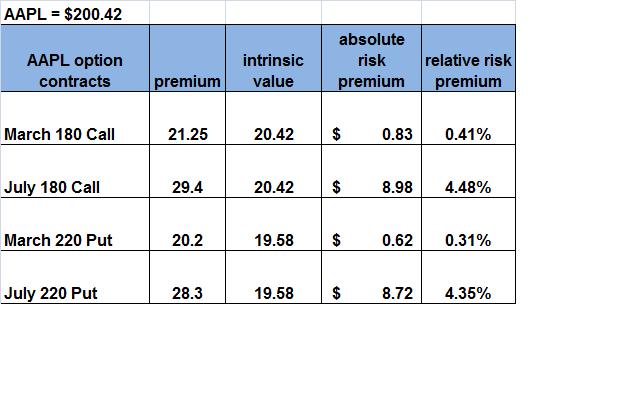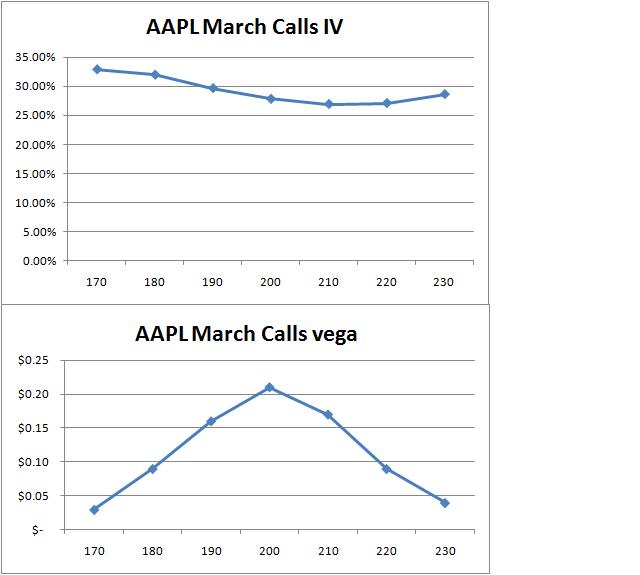At-the-money and out-the-money options’ premiums in most cases have small to no intrinsic value embedded in them.
Let take for example MSFT. The stock is currently traded at $28.77
MSFT $29 March call is currently traded at .56
MSFT $30 March call is traded at .22
There is no intrinsic value in any of the mentioned options. If you decide to buy them, you are essentially paying for the time to be right and to compensate the seller of the premium for the risk he is taking.
Options are bought for three main purposes: leverage, better risk control and hedging. In this post, I am going to focus on the first two.
At this point of time, MSFT is trading at $28.77.
MSFT $29 Call is currently offered for .56. The delta of that particular contract is .46, which means that for the next 1 dollar upward move in MSFT to 29.77, the $29 March call premium will increase by .46 to 1.02. A 3.5% move in the underlying asset (the stock) results in 82% move in the March $29 call. (it does matter how fast this move will happen, because options are wasting assets and as the time passes the time premium declines with the pace of theta. For this particular call option theta is currently at -.0119, which means that the option premium will decline by .0119 per day, ceteris paribus).
Risk management for an option trader should not be any different than the risk management for a stock trader. Assume that your trading capital is 100k and you are willing to risk .5% of your capital on every trading idea; therefore you are putting on risk $500 every time. In stock trading knowing your risk per trade helps to define the size of your position (how many shares you can afford to buy). In the options’ world knowing your risk per trade helps to define how many contracts you can afford to buy. Every time when you purchase an ATM or OTM option, you should assume that you will lose the whole premium that you pay. Therefore never risk more than you can afford to lose. In this case .5% of your capital or $500 per idea.
You should be a buyer of premium (calls or puts), when
– you have a directional bias: you expect the underlying assets to make a substantial move; for example you might expect a stock to be bid up in front of its earnings’ report date.
– when you expect the IV of your option to increase; What makes an IV of one option to increase? Simply explained – an imbalance between supply and demand in favor of the demand; There are more buyers than sellers for that particular option contract. The impact of IV is measured via vega, which shows the move in the option premium for each percentage point move in the IV.
The current IV of MSFT $29 March Call is 20.5% with a vega of .0316. If the IV doubles from 20.5% to 41%, the premium of that same call option will increase approximately by 20.5*0.0316 = .65.A $.65 increase caused just by the increase in the IV. Assuming there is no change in the stock’s price and the increase in IV happens overnight, the premium of that option should become .56+.65 = 1.11.
When does IV tend to rise?
IV of calls tends to rise in expectations of earnings. As the event approaches, the perceived risk increases and there are more buyers of premium. When I am bullish on certain stock, I like to buy calls 10 to 15 days before the earnings announcement. In this case I have two out of three elements on my side – delta (assuming the stock move in the expected direction) and vega (the increase in the IV). The only element that is against me is theta, but its negative effect is often more than offset by a sizable move in IV.
In the majority of the cases I make sure to sell my calls on the day before the earnings announcement date or earlier. Holding through earnings is usually a gamble, but there are cases when it could be done (I leave that for another post). The reason I tend to sell before the earnings announcement is called volatility crash – an immediate and humongous drop in the IV of an option contract, which affects negatively the premium. Many have lost money in options despite being right on the direction of the underlying asset. People buy a day or two before the earnings report is due, hoping to make a quick gain from a potential gap up on the news. There is no free lunch. In the majority of the cases, those people overpay in terms of IV. If the increase in the stock is not big enough to offset the drop in the IV, the option holder’s position will be in red.
The IV of put options tends to increase in expectation of earnings and when the underlying asset declines in value. Isn’t that perfect. You are bearish on certain stock, it drops and in the same time the IV of the purchased put increases. This is usually the case with the exception of the after earnings announcement volatility crash.
Options are wasting assets and when you are a buyer of premium it is preferable to give yourself more time to be right. The choice to buy 20-day or 180-day option will depend on your goal, analysis of the underlying stock and risk preference. When you are relying mainly on an increase of the IV in front of an earnings announcement, shorter-term options are preferable as the demand for them is bigger and therefore the potential for an increase in the IV higher. When your intention is to capture a nice size of the move of the underlying stock, it is better to use longer-term options, so you can have more time to be right.
This was the first post of a series of posts, in which I intend to explain how I use various options strategies, starting from the most simple to the more sophisticated ones. In the next post, I will explain the specifics behind buying in-the-money options.
 $0.83 per share more is an insignificant premium to pay for the leverage that the ITM option offers if AAPL start increasing between now and March 19.
$0.83 per share more is an insignificant premium to pay for the leverage that the ITM option offers if AAPL start increasing between now and March 19.